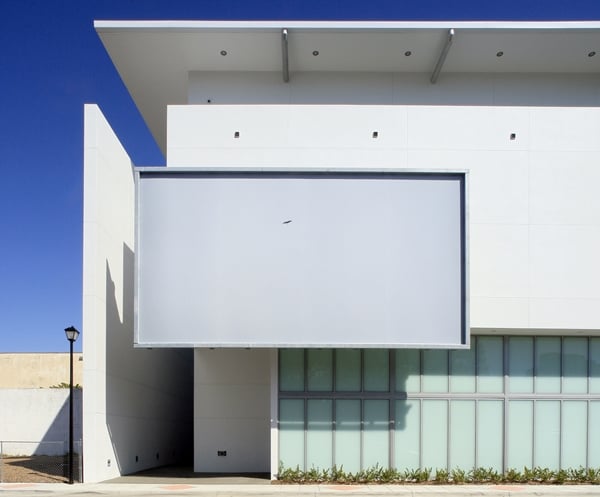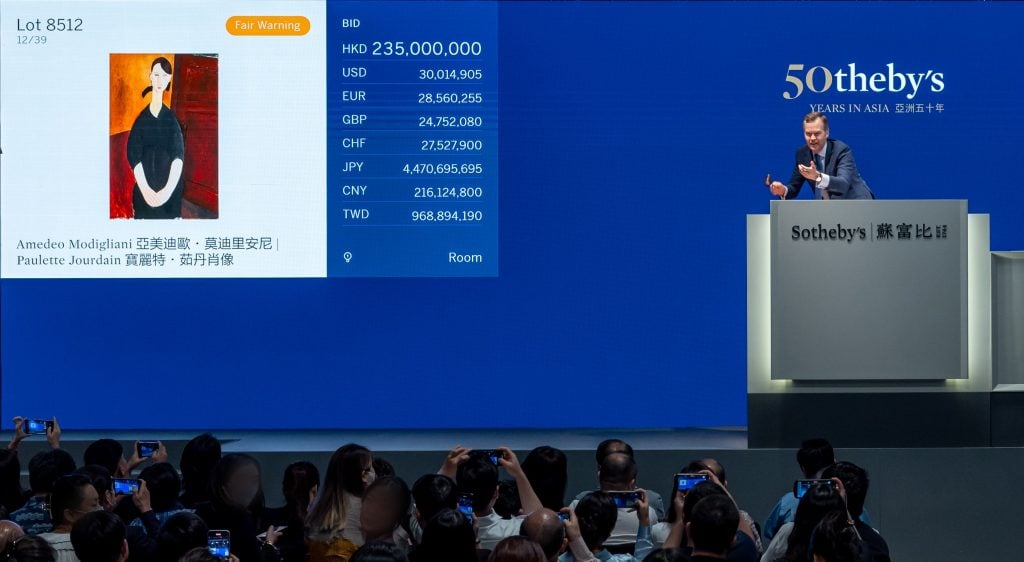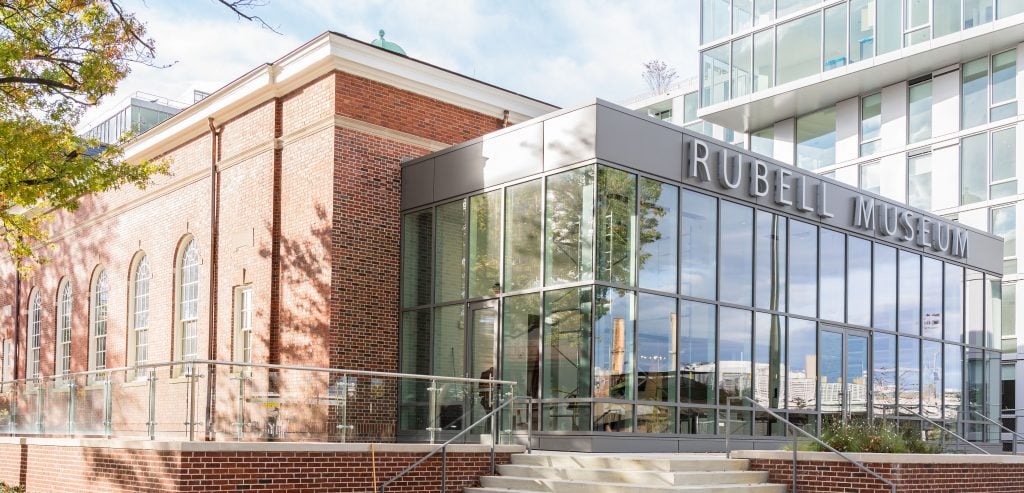A recent Instagram post by the collector and advisor Ralph DeLuca made me laugh.
At the top of the image, big, bold letters declare: “It was sold to a foundation…” Below, a photo shows an art handler pushing a crate into a cavernous warehouse that is filled with boxes, as far as the eye can see.
DeLuca wrote in a caption: “Who else is impressed with the staggering amount of new unknown foundations all over the world specifically wanting in-demand primary market emerging and contemporary paintings?”
I had been thinking a lot about private foundations—their proliferation and impact on the rise in prices for contemporary art. They are on the minds of many in the art industry right now, since the bellwether auctions in New York next month will feature works from Miami’s de la Cruz family, whose private foundation just abruptly closed, following the death of its founder, Rosa de la Cruz.

Felix González-Torres, Untitled (1995) on the exterior of the de la Cruz Collection Contemporary Art Space, Miami, Florida. Photo: Courtesy the de la Cruz Collection Contemporary Art Space, Miami, Florida.
“The word ‘foundation’ is one of the most misused words in the art world,” DeLuca told me this week, when I called him to talk about his post. “I don’t know why people hear the word ‘foundation’ and they think ‘public’ and ‘permanence.’ It sounds like a fortress, a safe place to put work.”
Galleries have long given preference to collectors with private foundations or museums when selling new work by hot artists, on the belief that the art would not be flipped for profit, potentially disrupting the artist’s market. Such buyers receive hefty discounts and often don’t have to abide by stringent non-resale agreements.
And yet private foundations regularly send their art to the auction block. This spring, Phillips is selling 450 photographs amassed by another Miami collector, Martin Margulies, including many displayed at his private museum, the Margulies Warehouse, to raise money for his Martin Z. Margulies Foundation.
Meanwhile, collector Dow Kim, who operates the Dow Kim Family Foundation, is the anonymous consignor of Nicolas Party’s Grotto (2019) at Christie’s, where it’s estimated at $2 million to $3 million.
Chinese entities have been especially active in selling. Last year, the Long Museum in Shanghai, which artists and dealers spoke of with hushed reverence for about a decade, sold many of its top holdings at Sotheby’s.

The sale of Amedeo Modigliani’s Paulette Jourdain (1919), the star lot of the auction of Long Museum collection at Sotheby’s Hong Kong on October 5, 2023. Courtesy Sotheby’s.
The Xiao Museum of Contemporary Art in Rizhao shuttered last summer, around the same time that its owner, Ding Yixiao, consigned to Sotheby’s London paintings by Louise Bonnet, Hilary Pecis, and Emily Mae Smith. He later withdrew them, citing adverse market conditions.
There was also an explosive lawsuit a couple years back over a flipped Cecily Brown painting that involved Michael Xufu Huang, the founder of the X Museum in Beijing, and previously a co-founder of the M Woods Museum in the city.
If foundations sell just like anyone else, are they betraying the trust placed in them by dealers? If a foundation is just a warehouse or a post-office box, how much does it really enhance an artist’s legacy? Do they merit the special treatment?
“With a few notable exceptions, it’s a tool for flippers,” DeLuca said.
The trend of foundations selling is alarming because the number of them has spiked in recent years—as has the amount of art that they hold. Many of these foundations bought art en masse. What would happen to artists’ markets if they started selling en masse, too?
‘They Can Do Whatever They Want’
The global foundation boom has been fueled by the unprecedented growth in ultra-wealthy individuals this millennium. As the billionaire ranks swelled, and art became to be viewed as an investment, more people decided to build private museums. These entities have risen to command an almost mythical power and status in the industry. And if they allow visitors, many coming through probably do not differentiate them from public museums.
“A foundation occupies a place a few notches down from a museum,” said Allegra LaViola, the owner of Sargent’s Daughters gallery in New York and Los Angeles, who has placed works with the Forge Project, an initiative by billionaire Gochman family. “There’s a sense of permanence, a wider reach, and serious intent. Just from the word itself, there’s an automatic elevation of a collection.”
The average private museum has 1,600 artworks, according to a 2023 report by the University of Amsterdam. Titled “Beyond the Global Boom: Private Art Museums in the 21st Century,” the publication identifies 446 institutions specializing in modern and contemporary art founded by private individuals with limited or no public funding. About 80 percent of them were established this century, according to the report. Germany leads the global count, with 60 such institutions, followed by the U.S. (59), and South Korea (50). China established 30 such entities in just nine years, the study says.
Growth came with criticism.
“Only a tiny part of this art is culturally relevant and worth the institutional treatment,” said Alain Servais, a Belgian collector who does not have a foundation, preferring to lend his art to public museums.
The sense of permanence attributed to private foundations and museums “is not real,” according to curator Francesco Bonami, who has worked for two private foundations—one in Italy, another in China. “Artists should be aware of that.”
And yet artists and their dealers bend over backward to sell to them. Many galleries willingly (if grudgingly) offer discounts as high as 50 percent to collectors Don and Mera Rubell for the privilege of placing work in their Rubell Museum, one of the top private collections of contemporary art in the country.

The Rubell Museum’s branch in Washington, D.C. Photo: Chi Lam.
While the Rubell Museum and other private institutions have nonprofit status, they are not accredited by the American Association of Museums, which has guidelines for its roughly 4,000 members on everything from humidity levels to deaccessioning.
“Private institutions can do things that museums can’t,” said George Lindemann, chairman of the board for the Bass museum. “They can do whatever they want.”
Nothing stops them from selling art, and few people would dare to ask to see their bylaws or estate planning.
“What happens after the owners die?” Lindemann said. “If the family has estate taxes, they’ll have to sell some stuff. When a chairman of the board of a museum dies, the thing keeps on going because the works are held in public trust.”
‘I Love Tauba Auerbach. I’ll Take Eight.’
Few galleries ask questions about the background of little-known private entities, especially in Asia.
“We don’t really know who these people are,” said one mega-gallery employee. “A foundation may be in someone’s garage.”
Bonami said that galleries don’t typically inquire about a foundation’s mission, or check if it has sold art before. “It’s a game that has certain rules, and the rules can get twisted according to the moment,” he said.
Many (foundation-less) collectors find the situation frustrating.
“Every gallery says, ‘We sell to institutions and foundations, and we have two paintings we can sell to collectors,’ ” one New York-based collector and advisor told me. “I don’t understand why I can’t get access. I have been doing this for over 20 years. I have a good name.”
To be sure, many private institutions do play important roles. The Rubell Museum is the most cutting-edge art space in Miami, either private or public, Lindemann said. The Broad in Los Angeles, a private contemporary art museum founded by Eli and Edythe Broad, greeted almost 900,000 visitors last year, well more than the Museum of Contemporary Art, a public institution across the street that Eli Broad helped to establish.
Among the deep-pocketed collectors who have taken the private-museum route, hiring star architects to build architectural marvels are Maurice and Paul Marciano, Peter Brant, Mitchell and Emily Rales, Cindy and Howard Rachofsky, Maja Hoffmann, and Maja Oeri. The list goes on and on.
These collectors wanted to be in charge of what to buy and how to display it. They didn’t want to wait years to see the art they bought for the museum “hanging next to 20 other things in a room,” the private dealer said. “They said, I am going to make my own room, and all of 20 things are going to be mine. And my name is going to be on the door.”
Bulk buying was a hallmark of the foundation boom.
“These collectors would come to galleries and say: ‘I love Tauba Auerbach. I’ll take eight. I love Wade Guyton. I’ll take six,’” the dealer said.
Rosa de la Cruz was one such buyer. On May 14, some of her Guyton and Auerbach paintings are returning to the market. Perhaps another private museum will bid on them.
Follow Artnet News on Facebook:
Want to stay ahead of the art world? Subscribe to our newsletter to get the breaking news, eye-opening interviews, and incisive critical takes that drive the conversation forward.
This post was originally published on this site be sure to check out more of their content





